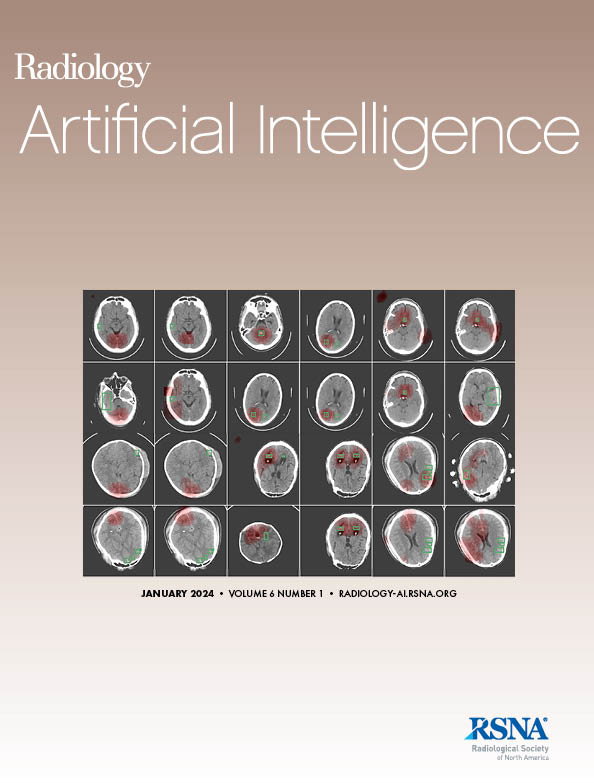Hao Li, Han Liu, Heinrich von Busch, Robert Grimm, Henkjan Huisman, Angela Tong, David Winkel, Tobias Penzkofer, Ivan Shabunin, Moon Hyung Choi, Qingsong Yang, Dieter Szolar, Steven Shea, Fergus Coakley, Mukesh Harisinghani, Ipek Oguz, Dorin Comaniciu, Ali Kamen, Bin Lou
下载PDF
{"title":"利用多部位双参数磁共振成像数据集,通过统一模型进行前列腺病变检测的基于深度学习的无监督领域适应。","authors":"Hao Li, Han Liu, Heinrich von Busch, Robert Grimm, Henkjan Huisman, Angela Tong, David Winkel, Tobias Penzkofer, Ivan Shabunin, Moon Hyung Choi, Qingsong Yang, Dieter Szolar, Steven Shea, Fergus Coakley, Mukesh Harisinghani, Ipek Oguz, Dorin Comaniciu, Ali Kamen, Bin Lou","doi":"10.1148/ryai.230521","DOIUrl":null,"url":null,"abstract":"<p><p>Purpose To determine whether the unsupervised domain adaptation (UDA) method with generated images improves the performance of a supervised learning (SL) model for prostate cancer (PCa) detection using multisite biparametric (bp) MRI datasets. Materials and Methods This retrospective study included data from 5150 patients (14 191 samples) collected across nine different imaging centers. A novel UDA method using a unified generative model was developed for PCa detection using multisite bpMRI datasets. This method translates diffusion-weighted imaging (DWI) acquisitions, including apparent diffusion coefficient (ADC) and individual diffusion-weighted (DW) images acquired using various <i>b</i> values, to align with the style of images acquired using <i>b</i> values recommended by Prostate Imaging Reporting and Data System (PI-RADS) guidelines. The generated ADC and DW images replace the original images for PCa detection. An independent set of 1692 test cases (2393 samples) was used for evaluation. The area under the receiver operating characteristic curve (AUC) was used as the primary metric, and statistical analysis was performed via bootstrapping. Results For all test cases, the AUC values for baseline SL and UDA methods were 0.73 and 0.79 (<i>P</i> < .001), respectively, for PCa lesions with PI-RADS score of 3 or greater and 0.77 and 0.80 (<i>P</i> < .001) for lesions with PI-RADS scores of 4 or greater. In the 361 test cases under the most unfavorable image acquisition setting, the AUC values for baseline SL and UDA were 0.49 and 0.76 (<i>P</i> < .001) for lesions with PI-RADS scores of 3 or greater and 0.50 and 0.77 (<i>P</i> < .001) for lesions with PI-RADS scores of 4 or greater. Conclusion UDA with generated images improved the performance of SL methods in PCa lesion detection across multisite datasets with various <i>b</i> values, especially for images acquired with significant deviations from the PI-RADS-recommended DWI protocol (eg, with an extremely high <i>b</i> value). <b>Keywords:</b> Prostate Cancer Detection, Multisite, Unsupervised Domain Adaptation, Diffusion-weighted Imaging, <i>b</i> Value <i>Supplemental material is available for this article.</i> © RSNA, 2024.</p>","PeriodicalId":29787,"journal":{"name":"Radiology-Artificial Intelligence","volume":" ","pages":"e230521"},"PeriodicalIF":13.2000,"publicationDate":"2024-09-01","publicationTypes":"Journal Article","fieldsOfStudy":null,"isOpenAccess":false,"openAccessPdf":"https://www.ncbi.nlm.nih.gov/pmc/articles/PMC11449150/pdf/","citationCount":"0","resultStr":"{\"title\":\"Deep Learning-based Unsupervised Domain Adaptation via a Unified Model for Prostate Lesion Detection Using Multisite Biparametric MRI Datasets.\",\"authors\":\"Hao Li, Han Liu, Heinrich von Busch, Robert Grimm, Henkjan Huisman, Angela Tong, David Winkel, Tobias Penzkofer, Ivan Shabunin, Moon Hyung Choi, Qingsong Yang, Dieter Szolar, Steven Shea, Fergus Coakley, Mukesh Harisinghani, Ipek Oguz, Dorin Comaniciu, Ali Kamen, Bin Lou\",\"doi\":\"10.1148/ryai.230521\",\"DOIUrl\":null,\"url\":null,\"abstract\":\"<p><p>Purpose To determine whether the unsupervised domain adaptation (UDA) method with generated images improves the performance of a supervised learning (SL) model for prostate cancer (PCa) detection using multisite biparametric (bp) MRI datasets. Materials and Methods This retrospective study included data from 5150 patients (14 191 samples) collected across nine different imaging centers. A novel UDA method using a unified generative model was developed for PCa detection using multisite bpMRI datasets. This method translates diffusion-weighted imaging (DWI) acquisitions, including apparent diffusion coefficient (ADC) and individual diffusion-weighted (DW) images acquired using various <i>b</i> values, to align with the style of images acquired using <i>b</i> values recommended by Prostate Imaging Reporting and Data System (PI-RADS) guidelines. The generated ADC and DW images replace the original images for PCa detection. An independent set of 1692 test cases (2393 samples) was used for evaluation. The area under the receiver operating characteristic curve (AUC) was used as the primary metric, and statistical analysis was performed via bootstrapping. Results For all test cases, the AUC values for baseline SL and UDA methods were 0.73 and 0.79 (<i>P</i> < .001), respectively, for PCa lesions with PI-RADS score of 3 or greater and 0.77 and 0.80 (<i>P</i> < .001) for lesions with PI-RADS scores of 4 or greater. In the 361 test cases under the most unfavorable image acquisition setting, the AUC values for baseline SL and UDA were 0.49 and 0.76 (<i>P</i> < .001) for lesions with PI-RADS scores of 3 or greater and 0.50 and 0.77 (<i>P</i> < .001) for lesions with PI-RADS scores of 4 or greater. Conclusion UDA with generated images improved the performance of SL methods in PCa lesion detection across multisite datasets with various <i>b</i> values, especially for images acquired with significant deviations from the PI-RADS-recommended DWI protocol (eg, with an extremely high <i>b</i> value). <b>Keywords:</b> Prostate Cancer Detection, Multisite, Unsupervised Domain Adaptation, Diffusion-weighted Imaging, <i>b</i> Value <i>Supplemental material is available for this article.</i> © RSNA, 2024.</p>\",\"PeriodicalId\":29787,\"journal\":{\"name\":\"Radiology-Artificial Intelligence\",\"volume\":\" \",\"pages\":\"e230521\"},\"PeriodicalIF\":13.2000,\"publicationDate\":\"2024-09-01\",\"publicationTypes\":\"Journal Article\",\"fieldsOfStudy\":null,\"isOpenAccess\":false,\"openAccessPdf\":\"https://www.ncbi.nlm.nih.gov/pmc/articles/PMC11449150/pdf/\",\"citationCount\":\"0\",\"resultStr\":null,\"platform\":\"Semanticscholar\",\"paperid\":null,\"PeriodicalName\":\"Radiology-Artificial Intelligence\",\"FirstCategoryId\":\"1085\",\"ListUrlMain\":\"https://doi.org/10.1148/ryai.230521\",\"RegionNum\":0,\"RegionCategory\":null,\"ArticlePicture\":[],\"TitleCN\":null,\"AbstractTextCN\":null,\"PMCID\":null,\"EPubDate\":\"\",\"PubModel\":\"\",\"JCR\":\"Q1\",\"JCRName\":\"COMPUTER SCIENCE, ARTIFICIAL INTELLIGENCE\",\"Score\":null,\"Total\":0}","platform":"Semanticscholar","paperid":null,"PeriodicalName":"Radiology-Artificial Intelligence","FirstCategoryId":"1085","ListUrlMain":"https://doi.org/10.1148/ryai.230521","RegionNum":0,"RegionCategory":null,"ArticlePicture":[],"TitleCN":null,"AbstractTextCN":null,"PMCID":null,"EPubDate":"","PubModel":"","JCR":"Q1","JCRName":"COMPUTER SCIENCE, ARTIFICIAL INTELLIGENCE","Score":null,"Total":0}
引用次数: 0
引用
批量引用

 求助内容:
求助内容: 应助结果提醒方式:
应助结果提醒方式:


